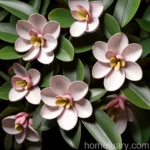Rosy Posy: Rhodohypoxis baurii ‘Helen’ – A Comprehensive Plant Profile
Plants play a crucial role in the ecology of our planet, and their diversity is both vast and fascinating. Among the myriad plant species, the Rosy Posy (Rhodohypoxis baurii ‘Helen’) stands out for its charming appearance and versatile uses in gardens, landscapes, and even as a container plant. In this extensive plant profile, we will delve into every aspect of the Rosy Posy, from its botanical characteristics to its cultivation, care, and maintenance. We will cover its cultural significance, uses, water and sunlight requirements, soil and fertilizer needs, pruning, propagation, and much more. Whether you are considering adding this lovely plant to your collection or are already a proud owner, this guide will equip you with all the essential knowledge to help you nurture and appreciate the beauty of the Rosy Posy.
What is the Rosy Posy (Rhodohypoxis baurii ‘Helen’)?
The Rosy Posy, scientifically known as Rhodohypoxis baurii ‘Helen’, is a striking flowering plant that belongs to the family Hypoxidaceae. This South African native species is recognized for its dainty, star-shaped flowers that come in various shades of pink and white. The plant typically forms low mounds of grass-like foliage adorned with an abundance of vibrant, rosette-shaped blooms, making it a delightful addition to any garden or landscape.
Key Takeaways
Here are the key takeaways about the Rosy Posy (Rhodohypoxis baurii ‘Helen’):
- Scientific Name: Rhodohypoxis baurii ‘Helen’
- Common Name: Rosy Posy
- Family: Hypoxidaceae
- Native to: South Africa
- Characteristics: Low mounds of grass-like foliage with star-shaped pink and white flowers
- Cultural Significance: Popular as a decorative garden and container plant
- Uses: Ground cover, container plant, garden borders, rock gardens, and landscaping
- Distinct Feature: Abundant flowering, especially in spring and summer
- Special Note: Suitable for both outdoor and indoor cultivation
Now that we have gained an overview of the Rosy Posy, let’s delve deeper into each aspect of this charming plant.
Culture of the Rosy Posy (Rhodohypoxis baurii ‘Helen’)
Cultivating the Rosy Posy involves understanding its specific requirements and preferences. This section will guide you through the essential cultural aspects of the plant, including its ideal environment, uses, and potential benefits within the landscape.
Uses
The Rosy Posy is a versatile plant that offers various uses, making it a valuable addition to gardens and landscapes. Some of its common uses include:
- Ground Cover: Its low-growing habit and abundant flowering make it an excellent ground cover plant, particularly in rock gardens and borders.
- Container Plant: The compact size and attractive flowers make the Rosy Posy an ideal choice for container gardening, adding color and charm to patios, balconies, and indoor spaces.
- Garden Borders: When planted in clusters, the Rosy Posy creates beautiful borders, enhancing the aesthetic appeal of garden beds and pathways.
- Rock Gardens: Its natural preference for well-draining soil and bright, sunny locations makes the Rosy Posy well-suited for rock gardens, where it can thrive in the company of other alpine and low-growing plants.
Water
Proper watering is crucial for the health and vigor of the Rosy Posy. While this plant appreciates consistent moisture, it is essential to avoid waterlogged conditions, which can lead to root rot and other moisture-related issues.
- Watering Frequency: During the active growing seasons of spring and summer, maintain a regular watering schedule, providing enough water to keep the soil consistently moist but not waterlogged. In autumn and winter, reduce the frequency of watering to allow the plant to enter a period of relative dormancy.
- Soil Moisture: Aim to keep the soil evenly moist, ensuring that water penetrates the root zone without creating waterlogging. Consider using a light mulch layer to help retain soil moisture and prevent rapid drying.
- Water Quality: Use clean, non-chlorinated water for irrigation, as some plants, including the Rosy Posy, can be sensitive to certain chemicals present in tap water.
Sunlight
The Rosy Posy thrives in bright, sunny locations but can also tolerate some light shade, especially in regions with intense summer sun. Providing the plant with the appropriate sunlight exposure is crucial for promoting healthy growth and abundant flowering.
- Sun Exposure: Position the Rosy Posy in a location that receives full sun for at least 6 to 8 hours a day. In hotter climates, partial shade during the hottest part of the day can help protect the plant from excessive heat and sunburn.
- Indoor Cultivation: When grown indoors, place the Rosy Posy near a bright, south- or west-facing window to ensure it receives an adequate amount of sunlight. Supplemental grow lights may be required in spaces with limited natural light.
Fertilizer
Like all plants, the Rosy Posy benefits from appropriate nutrient supplementation to support healthy growth and prolific flowering. Applying the right type and amount of fertilizer at the correct times is essential for maximizing the plant’s potential.
- Fertilizer Type: Use a balanced, water-soluble fertilizer designed for flowering plants. Look for a formulation with a higher phosphorus content to promote robust blooming and overall plant vigor.
- Application Frequency: Feed the Rosy Posy with a diluted fertilizer solution every 2 to 4 weeks during the active growing seasons of spring and summer. Reduce or eliminate fertilization during the plant’s dormant periods in autumn and winter.
- Application Method: Apply the fertilizer solution directly to the soil, ensuring that it reaches the root zone without coming into direct contact with the foliage to prevent potential burning or damage.
Soil
The soil requirements of the Rosy Posy are primarily centered around providing a well-draining and nutrient-rich growing medium to support its growth and blooming.
- Soil Type: Use a well-draining, slightly acidic to neutral soil blend for the Rosy Posy, such as a mix of loam, sand, and organic matter. A slightly sandy or gravelly texture can be beneficial for ensuring proper drainage and preventing waterlogged conditions.
- Amendments: Incorporate organic matter, such as compost or well-rotted manure, into the soil to enhance its fertility and structure. This can promote vigorous root development and overall plant health.
- Moisture Retention: While the soil should drain well, it should also retain enough moisture to support the plant’s growth. Adding a moisture-retentive amendment, such as peat moss or coconut coir, can help achieve a balanced soil texture.
Pruning
Pruning the Rosy Posy helps maintain its compact form, encourages prolific flowering, and removes any spent or unsightly growth. Understanding the proper pruning techniques is essential for ensuring the plant’s long-term health and attractiveness.
- Deadheading: Regularly remove spent flowers by gently pinching them off or using sanitized pruning shears. This practice encourages the plant to produce new blooms and prevents the formation of seed heads, redirecting its energy into further flowering.
- Trimming: During the growing season, lightly trim back any overly long or straggly stems to promote a bushier, more compact habit. Avoid heavy pruning, as the Rosy Posy’s foliage and flowers are produced from the current season’s growth.
Propagation
The propagation of the Rosy Posy can be achieved through several methods, allowing plant enthusiasts to multiply their collection and share the beauty of this plant with others.
- Division: Divide mature clumps of the Rosy Posy in early spring before the plant enters its active growth phase. Gently separate the clumps into smaller sections, each with a portion of the roots and growing points, and replant them in suitable locations.
- Offsets: Some varieties of the Rosy Posy produce offsets or plantlets around the base of the parent plant. These offsets can be carefully detached and replanted to establish new individual plants.
- Seed sowing: While less commonly used, propagating the Rosy Posy from seeds can be an option for obtaining new plants. Collect mature seeds and sow them in a well-draining, seed-starting mix, providing the appropriate temperature and moisture conditions for germination.
Container Popularity
The Rosy Posy’s compact size, attractive flowers, and adaptability make it a popular choice for container gardening enthusiasts. Whether grown on its own or combined with other compatible plants, it brings a touch of elegance and color to various urban and indoor settings.
- Container Selection: Choose a well-draining container with sufficient depth and width to accommodate the plant’s root system and allow for healthy growth. Terra-cotta, ceramic, or plastic pots can all be suitable, provided they have drainage holes to prevent water accumulation.
- Indoor and Outdoor Use: The Rosy Posy can be cultivated in containers both indoors and outdoors, offering flexibility in its placement and allowing individuals with limited garden space to enjoy its beauty.
- Decorative Impact: When grown in containers, the Rosy Posy serves as a beautiful centerpiece or accent, enhancing the aesthetic appeal of patios, balconies, terraces, and other similar spaces.
Common Diseases and Pest Management
While the Rosy Posy is generally a resilient plant, it is susceptible to certain diseases and pest infestations that can affect its health and appearance. Being aware of these potential issues and understanding their prevention and management is crucial for maintaining the plant’s vitality.
Common Diseases
Some common diseases that can afflict the Rosy Posy include:
- Botrytis Blight: This fungal disease, often encouraged by excessively wet conditions, can cause the development of fuzzy gray mold on the plant’s foliage, flowers, and stems. Providing proper ventilation and avoiding overhead watering can help prevent botrytis blight.
- Root Rot: Overly damp or waterlogged soil can lead to root rot in the Rosy Posy, causing wilting, yellowing, and eventual collapse of the plant. Proper watering practices and well-draining soil are essential in preventing this disease.
- Powdery Mildew: Powdery mildew can create a white, powdery coating on the leaves and stems of the Rosy Posy, impacting its overall health and appearance. Maintaining adequate air circulation and reducing humidity levels can help mitigate powdery mildew.
Disease Diagnosis
Detecting and diagnosing diseases in the Rosy Posy involves closely observing the plant and identifying any abnormal symptoms or signs of distress. Some key indicators of potential disease issues include:
- Yellowing or Browning Leaves: Discoloration of the foliage, especially if accompanied by wilting or curling, can signal underlying disease problems, such as fungal infections or nutrient deficiencies.
- Abnormal Growth Patterns: Stunted growth, distorted leaves, or failure to produce new shoots and flowers may indicate the presence of a disease impacting the plant’s vitality.
- Visible Spots or Growths: Any visible signs of mold, mildew, or unusual growths on the foliage and stems should be promptly investigated to determine the cause and appropriate management strategy.
Common Pests
The Rosy Posy can be vulnerable to attack by certain pests, which, if left unchecked, can negatively impact its growth and flowering. Some common pests that may affect the plant include:
- Aphids: Small, soft-bodied insects that can cluster on the undersides of leaves and along tender shoots, sucking sap from the plant and causing leaf distortion and yellowing.
- Spider Mites: These tiny arachnids can infest the Rosy Posy, especially in dry and warm conditions, leading to stippling of the foliage, webbing, and overall decline in plant health.
- Thrips: Thrips are slender insects that feed on the plant’s cells, causing silvery or bronze stippling on the foliage, as well as distorted growth.
Pest Control
Implementing effective pest control measures is essential for safeguarding the health and appearance of the Rosy Posy. Integrated pest management strategies, such as the following, can help manage and prevent pest infestations:
- Natural Predators: Encourage the presence of beneficial insects and predators, such as ladybugs, lacewings, and predatory mites, which feed on common pests like aphids and spider mites.
- Horticultural Oils: Applying horticultural oils can help suffocate and eliminate soft-bodied pests like aphids and spider mites, reducing their populations and minimizing damage to the plant.
- Regular Inspections: Routinely inspect the Rosy Posy for signs of pest activity, including the presence of eggs, nymphs, or adult insects, and promptly address any issues to prevent widespread infestations.
Botanist’s Tips for Cultivating the Rosy Posy
Cultivating the Rosy Posy can be an immensely rewarding experience, especially when armed with the right knowledge and techniques. Here are some expert tips and recommendations for nurturing this beautiful plant:
- Utilize Well-Draining Soil: Ensure the planting soil or growing medium drains well to prevent waterlogging and promote healthy root development.
- Monitor Moisture Levels: Regularly check the soil moisture to maintain the right balance between dryness and excessive wetness, adjusting your watering frequency as necessary.
- Provide Adequate Sunlight: Position the Rosy Posy in a location that receives ample sunlight, especially during the growing season, to support robust flowering and healthy growth.
- Practice Regular Deadheading: Removing spent flowers not only keeps the plant looking neat and attractive but also encourages the production of new blooms, prolonging the flowering period.
- Watch for Signs of Stress: Keep an eye out for any signs of disease, pest infestations, or environmental stress, and take prompt action to address these issues before they escalate.
- Share Insights with Fellow Gardeners: If you find success in growing the Rosy Posy, consider sharing your experiences and insights with other gardening enthusiasts, spreading the joy of cultivating this lovely plant.
Fun Facts about the Rosy Posy (Rhodohypoxis baurii ‘Helen’)
Uncover some intriguing and delightful facts about the Rosy Posy that showcase its unique characteristics and appeal:
- The name “Rhodohypoxis” is derived from the Greek words “rhodon” (rose) and “hypo” (below), referring to the position of the flowers under the leaves.
- The Rosy Posy is valued not only for its ornamental beauty but also for its ability to attract pollinators such as bees and butterflies, contributing to the local ecosystem and biodiversity.
- This plant’s compact size and dainty appearance make it a popular choice for miniature and fairy gardens, adding a charming touch to these whimsical landscapes.
Links to External Resources
For further information and resources on the Rosy Posy and its cultivation, refer to the following:
- Royal Horticultural Society – Rhodohypoxis
- Missouri Botanical Garden – Rhodohypoxis baurii ‘Helen’
- University of Florida IFAS Extension – Ground Covers for Central Florida
- American Society for the Prevention of Cruelty to Animals (ASPCA) – List of Plants Toxic to Dogs
By exploring the diverse facets of the Rosy Posy (Rhodohypoxis baurii ‘Helen’), we have uncovered its beauty, versatility, and potential to enhance gardens, landscapes, and indoor spaces. Whether you are a seasoned gardener or a beginner with a passion for plants, the Rosy Posy presents an enchanting opportunity to engage with nature and cultivate a plant that embodies both elegance and resilience. As you embark on your journey with this delightful species, may these insights and tips guide you in nurturing the Rosy Posy to its fullest potential, enriching your horticultural pursuits and the beauty of your surroundings.
Happy gardening!
Note: This blog post is intended for informational purposes only and does not constitute professional botanical advice. Always consult with local gardening experts and resources for specific plant care recommendations in your region.















